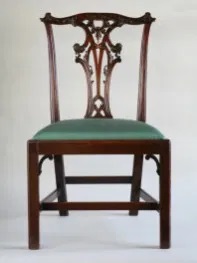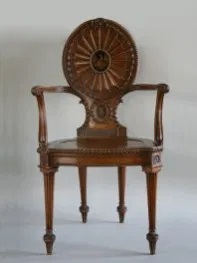Nostell Priory in the Age of Chippendale
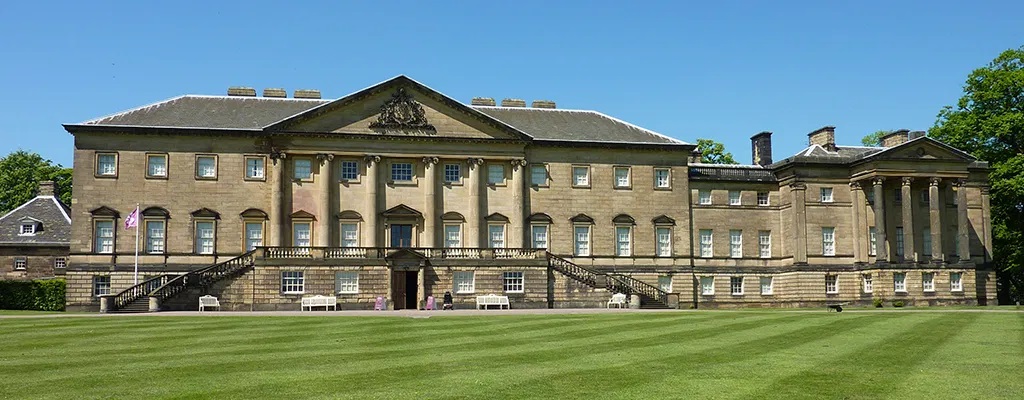
Although the Trust’s Fall 2016 Study Trip Abroad is subtitled “Yorkshire in the Age of Chippendale,” the 18th century was just as much the age of Adam, Paine, and Brown, all designers and craftsmen whose collaboration—and competition—were equally responsible for the golden age of the 18th-century country house. A combination of factors helped create the remarkable edifices and interiors of this era: political stability, economic growth, the philosophical influence of the Enlightenment, and the historical and aesthetic reawakening of those making the Grand Tour on the continent. Any one of the houses on our schedule could be considered a representative sample, but Nostell Priory, near the town of Wakefield in West Yorkshire, possesses particular charm, as well as a noteworthy record of successive campaigns of building, decoration, and furnishing.
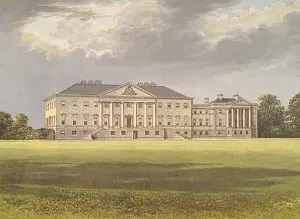
Nostell Priory as depicted in “Country Seats of Noblemen and Gentleman,” by Francis Morris, 1880 edition. Image courtesy of Wikimedia Commons.
Writing about the English stately home involves as much genealogy as it does architectural and design history, and each subsequent campaign of building and redecorating can be tied to a specific generation–although in many cases the principal figures of each generation bear the same name. In the case of Nostell Priory, the family name tends to be Rowland Winn, Baronet Nostell. The current house was built by the 4th and 5th Baronets Nostell, who each benefitted from financially advantageous marriages and curated the most fashionable tastes and trends of the era by going on a Grand Tour.
Construction on the current house began in 1735 under the direction of James Paine. The selection of Paine, then 18 years old and unknown, by the 4th Baronet was a surprise. Paine was enthusiastic, however, and fortuitously possessed access to James Gibbs’ Book of Architecture. The austere Palladian house, renamed Nostell Priory following 110 years as Nostell Hall, represented the height of fashion in the 1740s. Paine was retained on and off at Nostell for the next thirty years as Clerk of Works and ad hoc decorator. Formally establishing an architectural practice in 1750, Paine also worked on a number of homes throughout West Yorkshire, eventually publishing two volumes of Plans, elevations, and sections of Noblemen and Gentlemen’s Houses (featuring many of his own commissions) before being named in 1780 as Architect of the Office of Works, the department of the overseeing the maintenance of the Royal Family’s castles and palaces throughout the country. Today, Paine’s sumptuous late-Baroque interiors, which contrast strikingly with his relatively plain exteriors, survive at Nostell Priory most notably in the South Staircase, State Dining Room, and the Crimson Room.
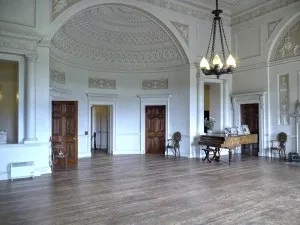
Robert Adam’s Top Hall at Nostell Priory.
Unfortunately for Paine’s career, his aesthetic loyalties remained with the Baroque for his entire life, which caused an unfortunate professional slump in the later 1780s. Upon the 4th Baronet of Nostell’s death in 1765, his son the 5th Baronet (another Rowland Winn), ditched Paine for Robert Adam. A full decade younger, Robert Adam was the wunderkind of the mid-18th-century architects. Nostell Priory was one of two grand houses Adam snatched from the teeth of John Paine, and, unfortunately for the elder’s ego, Adam was also appointed to full term as Architect of the Office of Works in 1761, a good two decades before Paine received the honor himself. Adam produced a series of grand designs for the house, adding a curved double staircase to the front façade, and building the first of what was supposed to be four additional pavilions, extending from the four corners of Paine’s original block. Where Robert Adam truly introduced the Grand Tour at Nostell Priory was in his interiors. The Top Hall in particular is a masterpiece of neoclassicism, with the delicate plasterwork on the ceiling, frieze, and apse, providing a theme and variation on the architectural ornament of ancient Rome. The hall is missing the vibrant pastel colors of many of Adam’s other creations, but beautifully emphasizes the extraordinary oval-backed chairs by Thomas Chippendale.
Chippendale was brought on the work at Nostell in 1766 at the recommendation of Adam, although a (likely baseless) family legend has the teenage furniture virtuoso collaborating with John Paine to build an oversized doll house for the Winn family, still on display today. At the height of his career, Chippendale delivered some of his most technically advanced and creative work to Nostell Priory, including these chairs, a suite of extraordinary japanned green furniture. Some of his commissions hearkened back to his iconic pieces made famous in his The Gentleman and Cabinet Maker’s Director of 1754, and, unusually, he seems to have supplied mundane household objects for the staff spaces as well.
Circa 1770, Mahogany, Nostell Priory, attributed to Thomas Chippendale. Image courtesy of the National Trust. One of six dining chairs supplied to the Winns, directly quoting from designs appearing in both the 1754 and 1762 editions of the “Director.” Image courtesy of the National Trust.
1771, lacquered wood, Nostell Priory, Thomas Chippendale. Supplied for the State Apartment in 1771. Image courtesy of the National Trust.
Chair, c. 1770-75, pollard oak inlay, painted finish, Nostell Priory, attributed to Thomas Chippendale. These turned and carved oval-back chairs feature the Winn family crest, and were originally japanned or painted white to better coordinate with the plasterwork in Nostell Priory’s Top Hall. They were faux-grained in 1821. Image courtesy of the National Trust.
Perhaps it is because he possessed the artistic flexibility and adaptability that others like Paine did not that Chippendale’s name has become most strongly associated with 18th-century furnishings and interiors, and most of the houses we will be seeing proudly display his many fine commissions. At Nostell Priory, Adam and Chippendale’s superb collaboration ended with the furniture maker’s death in 1779. Thomas Chippendale the Younger continued his father’s tradition of commissions for the Winn family, including the fashionable giltwood seating for the music room, and the collaboration may well have continued for several more years had not the 5th Baronet died suddenly in a carriage accident in 1785. Work stopped immediately, and Adam’s plans for the house, including three more extensions to Paine’s original block, were never realized, as the house’s unusually asymmetrical appearance today bears witness. The 6th Baronet (also Rowland Winn), was aged only 10, and in his adulthood he proved interested primarily in hunting and sports, to the exclusion of building, decorating, marrying, and having children, in any order whatsoever. When he died at the age of thirty in 1805, the title and family name died with him.
Fortunately for the preservation of the house, the children of the 6th Baronet’s sister, Esther Williamson, inherited the house and its contents, and embraced their heritage with enthusiasm. This did, however, include taking on the Winn surname, and producing several more generations of Rowland Winns, who by the 1880s were re-elevated to the peerage with the title Baronets St. Oswald, in reference to the patron saint of the original medieval Nostell Priory. While they added to the both the fine and decorative arts collection of the house, they kept Adam’s completed interiors, along with the furniture designed both by the architect and Chippendale. In 1953, descendants of the family turned Nostell Priory and its contents over to the National Trust, while retaining private apartments on an upper floor for personal use. Since then, the house, surrounding park, and its contents have been on public view, providing a wonderful record of this unique period in British history!
About The Decorative Arts Trust Bulletin
Formerly known as the "blog,” the Bulletin features new research and scholarship, travelogues, book reviews, and museum and gallery exhibitions. The Bulletin complements The Magazine of the Decorative Arts Trust, our biannual members publication.








